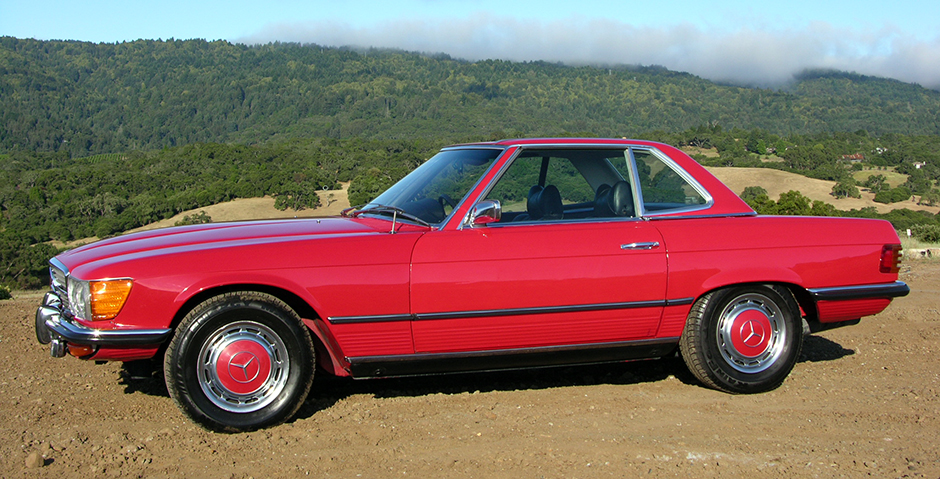
Most Popular SL yet
The 107 Series
In April 1971 a new Mercedes-Benz 350 SL took to the road and captured the hearts of the customers. Powerful, self-assured and representative, it showed itself to be a well-proportioned roadster on all counts and was also given an equally successful, removable hard top by its designers. In addition to elegance and quality the bodywork had an aura of safety, for the crash behavior of this open two-seater was well ahead of its time. The first eight-cylinder to be installed in an SL lay under the stretched bonnet.
Momentous decisions
Strictly speaking the R 107, which is the in-house designation for the ’71 SL, should be called the ’68, for it was on June 18, 1968 that the Executive Board took the final decision to build the car after a series of lively debates. These partly concerned the question of whether one should not turn the roadster into a coupe with a sliding roof, for alarming news relating to the safety of open-top cars was coming from the USA. This was a knife-edge decision which finally went the SL’s way, as history confirms.
The fact that a decision so important for the entire model series was reached in favor of a roadster with a removable hard top like its predecessors was primarily due to the head of development Dr. Hans Scherenberg, who fought for the idea vehemently: “The SL gave me great pleasure but also cost me a great deal of effort. We didn’t reach this decision easily”, is his summary of that momentous meeting.
This left the question of a coupe still unanswered of course. No decision was reached that same day, but background discussions continued on whether a four-seater sports coupe based on the R 107 should be produced as well, or whether a model designed as an “image coupe” might be feasible on the basis of the coming S-Class at a much later stage, almost the mid-seventies.
Karl Wilfert, the head of body design in Sindelfingen, had developed a coupe based on the R 107 practically off his own bat, and one day he presented this to the Executive Board as a “study”. Meeting with initial rejection Wilfert exhibited his characteristic persistence and was finally able to prevail with his idea of a sports coupe, later to become the SLC – with resounding success as subsequent years showed.
Moreover, the SL had the “fastest” and easiest soft top of any convertible or roadster, an ingeniously simple design that had no automated features.
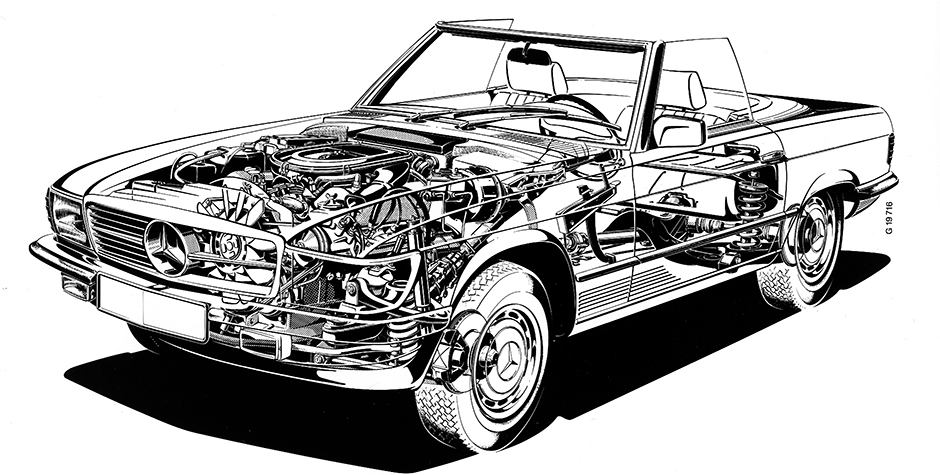
The new SL’s structure provided a safe cocoon in which its wealthy owners could enjoy comfortable touring. Lightness was not a hallmark of this new Sports Light model.
Roadster safety
Béla Barényi’s safety concept with front and rear crumple zones and a rigid passenger cell – the “three-box principle” – was also reflected in the SL of 1971. The backbone of the R 107 was not simply a shortened and reinforced saloon floor assembly as in the case of its predecessor, but rather an autonomous frame construction with an enclosed transmission tunnel and box-section cross-members and side members whose special feature was different metal thicknesses and the resulting, defined deformation
As the SL was definitely to be a genuine open-top car without the “fig-leaf” of a Targa-type rollover bar, the only safety potential for the roadster in the event of a rollover resided in the A-pillars and windscreen. These were fundamentally redeveloped and possessed a 50 percent greater strength than the previously produced version. In addition the windscreen was bonded into its frame to increase strength.
The result was excellent resistance during the roof drop test, which meant that even without a Targa-bar the open-top car was considered acceptable by the safety experts in the USA. Naturally the rear window in the hard top was likewise bonded in place.

107’s design was an exercise in parallel elements. Ribbed lower body panels relieved some coachwork bulk and ribbed tail lights remained clearer longer.
Interior safety
Even the interior features trailblazing innovations. The instrument panel was energy-absorbing and foam-covered both at the top and at knee level. Another innovation was the four-spoke steering wheel, freshly designed to reflect the findings of accident researchers. This retained the well-proven impact-absorbing boss, however the rim, padded face and boss were set in polyurethane foam. A telescopic safety steering column and the steering gear located behind the front axle completed the safety measures beneath the skin.
A number of details made living with this car highly enjoyable. The legibility of the three dial instruments was exemplary, as were the ergonomics of the controls. The seats were fitted with head restraints and automatic seat belts from the start. Customers who really wanted to were able to specify a kind of “sitting space” behind the seats in place of the standard luggage space, though its utility value was liter-ally strictly limited.
Climatic comfort and stress-relieving safety were provided by a highly responsive heating system which operated without reference to back pressure and was con-trolled by flaps, supported by an innovative heating and ventilation system in the doors. As an afterthought there was a rechargeable torch integrated into the glove compartment.
Dirt-repelling claddings on the A-pillars and exterior mirrors ensured good visibility even in bad weather conditions. The windscreen wipers located close together in the center swept a remarkable 70 percent of the windscreen surface, were always optimally positioned in the airflow and would not lift even at high speeds.
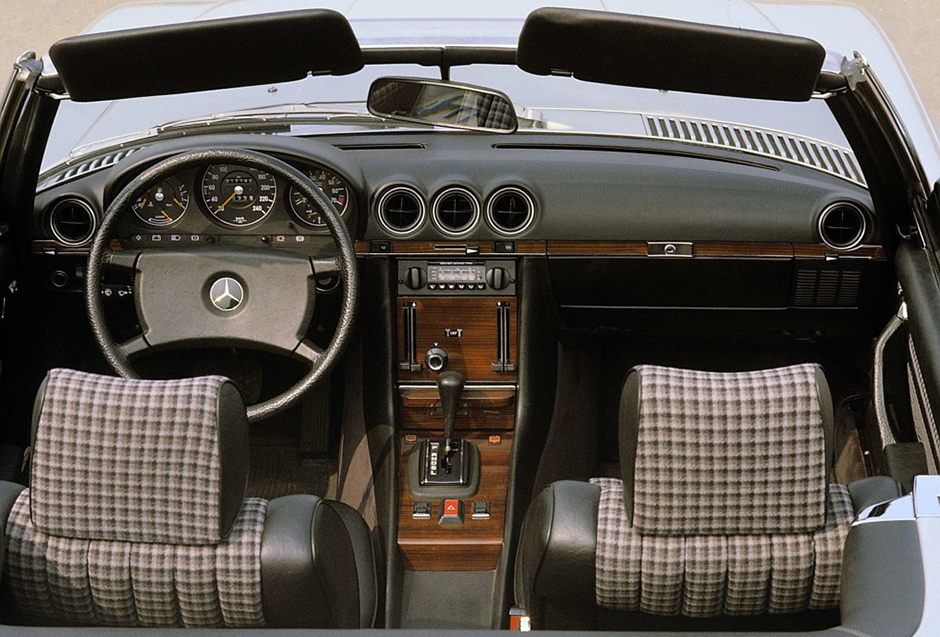
New interior featured deformable dash pad and clearly legible instrumentation. This is a post – 1980 Euro car with plaid seat inserts.
An immediate bestseller
In fact it was not the safety aspects that led customers all over the world to snap up the new SL as soon as they could. It was the offer of a successfully designed, open-top car, the only one in series production and therefore automatically attractive.
The striking front-end with the dominant SL face, the wide-band headlamps and the ribbed indicator lenses gave an impression of power, the lines of the low silhouette were open with the top down and harmonious with the hardtop in-stalled, while the slightly concave trunk lid was reminiscent of the “pagoda” era. The highly dirt-resistant, ribbed wide-band rear lights gave a powerful, masculine touch to the rear end.
Moreover, the SL had the “fastest” and easiest soft top of any convertible or roadster, an ingeniously simple design that had no automated features. When folded down it disappeared beneath a cover, as with its predecessors.
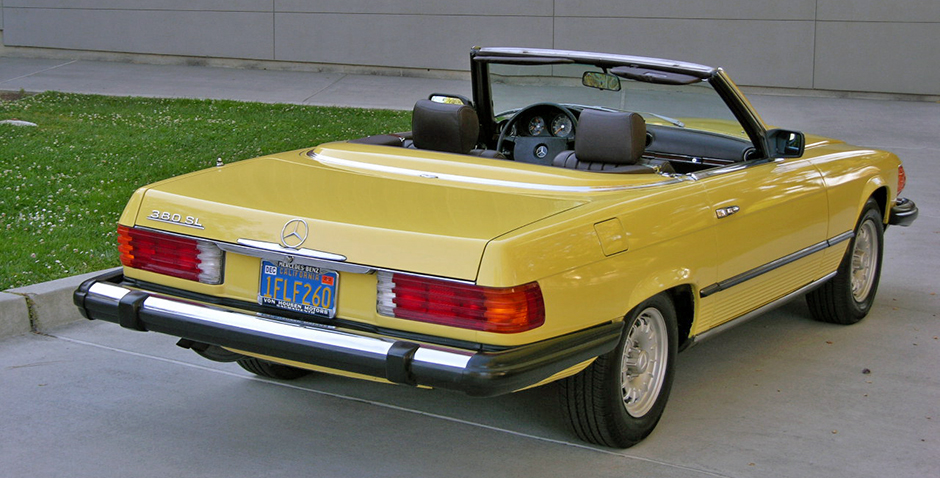
380SLs were much maligned for an underweight timing chain system that caused many catastrophic failures. This US model is finished in the fairly rare Sun Yellow.
The engines
In its very successful if initially unplanned 18-year production history, a whole range of six and eight-cylinder engines were installed in this SL and the model designations were correspondingly varied.
When series production began the new SL sported the familiar 3.5-litre eight-cylinder engine that had already been premiered in the 280 SE 3.5 coupe and convertible in 1969 and enjoyed a superb reputation ever since. Its 200 hp at 5800 rpm gave the nearly 1600 kilograms of the SL an acceleration from stand-still to 100 km/h in 9 seconds. The newcomer easily reached 210 km/h, thus surpassing that of its predecessor by a good 10 km/h.
The 280 SL with 185 hp from 1974 to 1985 and the 300 SL from 1985 generating 188 hp without and 180 hp with a catalytic converter were members of the very successful six-cylinder contingent. These had almost the same performance as the smaller eight-cylinder models but were less expensive and less thirsty.
The eight-cylinder models made their first appearance with the 200 hp 350 SL, which was produced from 1971 to 1980. Its bigger brother the 450 SL, which was in the range from March 1973, had 225 hp to offer. In 1980 they were followed by the 500 SL with an all-alloy engine and 240 hp, which, after a thorough redesign in 1985 generated 245 hp and remained in the range with a greatly reduced fuel consumption until the series was discontinued in 1989.
The 350 was replaced in 1980 by the 380 SL and in 1985 by the new 420 SL, which produced 218 hp without and 204 hp with a catalytic converter. One slightly exotic family member was the 560 SL, which was only available in the US market, featured an “American” catalytic converter and generated an output of 230 hp.
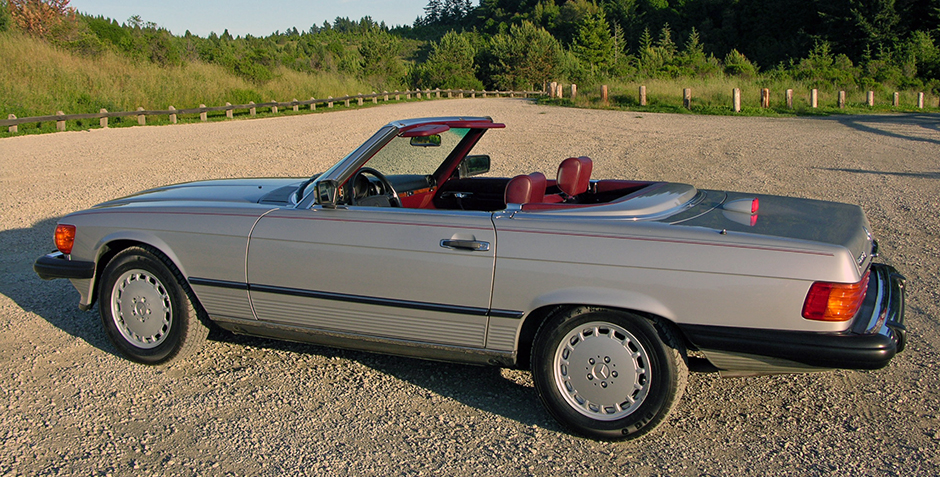
US specification 560SL was produced from 1986-1989 and produces about 240hp.
What we need is a coupe
In 1961, on the basis of the famous “fintail”, Daimler-Benz had presented both a coupe and a convertible which were to be followed by a new model after an appropriate period in production. The next “platform”, the gradually maturing new S-Class, was however not available in time to introduce a coupe on that basis at the beginning of the 1970s. The SL was therefore used as a basis, especially since a well-advanced design by Karl Wilfert was waiting to be realized in the prototype shop in Sindelfingen.
The SLC, the official name given to the “sports coupe”, celebrated its premiere at the Paris Motor Show in October 1971. Up to the windscreen its exterior matched that of the roadster, but then things went up and away for greater length. In a gentle curve the four-seater passenger compartment was surmounted by a flat roof, which ended at the enormous rear window and which was curved in two directions and heavily inclined. This in turn gave the rear end a comparatively opulent length, the boot lid having a slightly convex profile in contrast to the roadster.
Viewed from the side the length was firstly emphasized by the longer wheelbase, 2820 versus 2460 millimeters, and secondly by the line of the side windows, which had to be fully retractable and without the interruption of a B-pillar as was usual in a Mercedes-Benz coupe.
In the case of the SLC an obstacle was encountered in this respect, for the short distance between the door and the rear wheel arch required a highly complicated and therefore probably not entirely reliable, rotary tipping mechanism to lower the rear side windows. Karl Wilfert’s solution to the dilemma were the stylistically controversial but very striking, double-glazed “sidelights” with integral louvres, which divided the side windows and made them smaller for easy lowering.
For the first time this car also accommodated the standard first-aid kit in a special recess beneath the rear window, where it is located in all subsequent Mercedes-Benz models.
The SLC was in production from 1971 to 1981 as the 280, 350, 380, 450 and 500 SLC, with the same engines and transmissions as the roadster. One exception from 1978 to 1980 was the 450 SLC 5.0, which saw the debut of the new five-liter V8 light-alloy engine. For the first time in the 107-series this model was also equipped with a front apron and a rear spoiler of contoured rubber.
The drag coefficient of the SLC proved to be considerably better than that of the SL, enabling it to achieve the same performance despite a weight penalty of 45 to 50 kilograms.
During its ten-year production history the SLC was purchased by a total of 62,888 customers. One particularly remarkable aspect is that it fully lived up to its classification as a “sports coupe”, for it produced many victories for Mercedes-Benz in rallies and long-distance races.
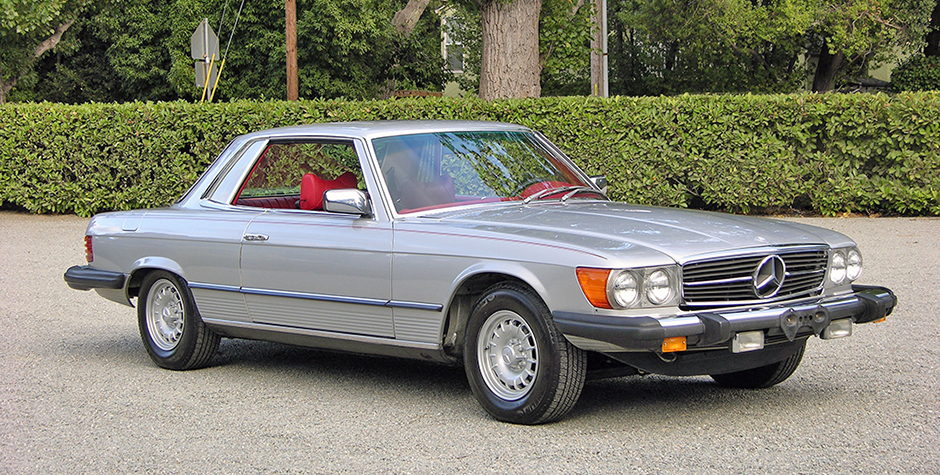
SLC’s extra length eroded the SL’s purity of line. Vast pillerless side window aperture was relieved by the addition of fixed, fluted rear quarter windows. Handsome automobile nevertheless.
Sport has its due as well
In 1977, after a long period of abstinence, the first, second, sixth and eighth places achieved by Daimler-Benz in the London – Sydney long-distance rally were a first great success for the company’s reawakened sporting commitment.
The 280 E and the 450 SLC 5.0 were the obvious choices for the impending 1978 activities. These cars most nearly corresponded to series production and there-fore the racing rules, and only needed to be equipped with additional long-range headlamps, headlamp covers, a raised suspension, bucket seats, a rollover cage, additional fuel pumps and a tripmaster. A brave new team led by the gifted driver, strategist and organizer Erich Waxenberger took up the challenge. They were out to win, and the reputation of the company demanded it.
The first challenge was the “Vuelta a la Americana Sud”, a huge rally covering almost 30 000 kilometers through ten South American countries from August 17 to September 24, 1978. The result was a resounding success, for the first five places went to Mercedes-Benz, the 450 SLC 5.0 taking first, second and fourth place, the 280 E third and fifth place. In 1979 this was followed by the East African Safari from April 12 to16, which ended with a consoling second and sixth place for the 450 SLC 5.0 and a fourth place for the 280 E after a string of problems, breakdowns and faults.
The Bandama Rally through the savannas of the Ivory Coast from December 9 to14, 1979 covered more than 5600 kilometers and ended with a quadruple victory for the Mercedes-Benz crew. The 1972 result shows how tough this rally was, for on that occasion not a single car reached the finishing line and there was accordingly no winner. In 1980 the 450 SLC 5.0 was reengineered again, its weight reduced where possible and the wheel arches and wings enlarged to take wider, larger tires. The next event from March 4 to 9 was the Portuguese Rally, which ended with a fourth and fifth place. The Kenya Safari from April 3 to 7 was a disappointment with a third, sixth and tenth place.
The Acropolis Rally took place from May 24 to 30. 15 years beforehand Dieter Glemser had at least achieved a place on the winner’s rostrum at this event, how-ever this time there was only a minor ranking. Brake failures, steering components bent by large stones, fractured fuel lines and lost filler caps had continually stymied the team or hopelessly delayed their progress. At the Codasur Rally in Argentina from July 19 to 25 yet another attempt was made, however only one team reached the finish and took second place.
From September 13 to 17 the indefatigable team were able to admire the very narrow, tortuous roads of New Zealand, where a massive rally car like the 500 SLC found itself in an almost hopeless position. Although the car was too long and heavy, sheer desperation enabled the team to achieve two respectable rankings, the results showing the 500 SLCs in fourth and fifth place.
The next Bandama Rally in December brought “only” a double victory, but at least 50 percent of the SLCs entered reached the finishing line without mishaps – a marvelous achievement for this rally, which had only 792 kilometers of asphalt roads in its overall length of 5336 kilometers. And the last achievement, for at the end of the 1980 season Daimler-Benz withdrew from sporting competition.
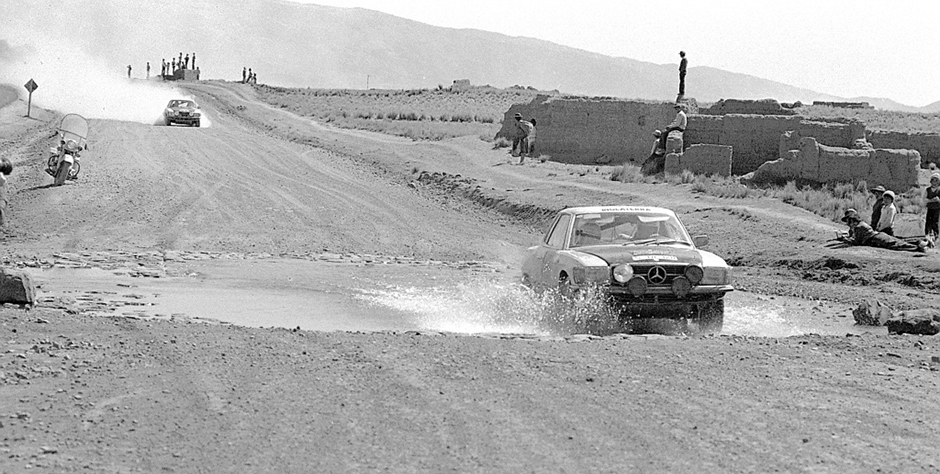
The factory 5.0 liter SLCs slog through a rally stage in 1978. While it was an unlikely rally machine, it did score outright victories.
A legend, or to be continued
What came after 1971 was a legend in itself for the next 18 years. Initially appearing on the roads as the 350 SL, this sportscar became the most successful Mercedes roadster of all. With 237,297 examples produced it became a modern classic even during its own “lifetime”. It featured a hardtop with a slightly pagoda-shaped roof which was matched by a gently concave boot lid – not so good for the aerodynamics but good for the character. For the first time the SL became available with an eight-cylinder engine, a catalytic converter and the anti-lock braking system ABS.
daimler ag
photography/daimler ag and mercedesheritage